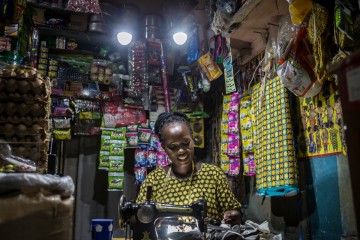- About
- Topics
- Story
- Magazine
- In-Depth
- Picks
- Opinion
- News
- Donate
- Signup for our newsletterOur Editors' Best PicksSend
Read, Debate: Engage.
In Sub Saharan Africa seven out of ten people do not have access to electricity.
The abundant sun is, however, being harnessed to reverse the sorry state of affairs. From initially powering homes, solar energy has been tapped in key infrastructural projects. One such project is South Africa’s George Airport located in the Western Cape Province which recently became the first airport in Africa to run on solar power.
The 200-square-meter solar facility, which costs a little above $1million, will meet approximately 40 per cent of the airport’s energy initially and is expected to produce 750Kw power when it reaches full capacity.
It has 3,000 photovoltaic modules which will generate electricity from solar radiation. It has been hailed as a major breakthrough in reducing over-reliance on the unreliable national grid, while reducing water wastage for an airport that handles 600,000 passengers every year and being a key distribution point for cargo including horticulture and seafood.
"Harnessing solar power is a viable cleaner energy source which contributes towards diversifying the energy mix. This plant will ensure that the airport is self-sustaining in terms of its power needs, and will eventually extend to the broader community within the George municipality," said Skhumbuzo Macozoma, chairman of the Airports Company South Africa (ACSA) Board.
ACSA is state-owned and manages nine airports in the country. The ultimate goal, the agency says, is to ensure that all airports in the country run on renewable energy.
“This admirably demonstrates the South African government’s commitment to clean energy generation and sustainability, as well as to our country’s increasingly prominent role when it comes to global climate change issues,” said Dipuo Peters, South Africa’s minister of transport during the launch of the facility.
The launch of the solar facility at the airport comes a year after Cochin International Airport in India unveiled the world’s first airport solar power plant which produces 60,000 units of electricity daily surpassing the daily requirements at the airport. The plant costs $9.5 million.
But it also comes at a time when other African countries are rolling out mega solar projects that have caught world attention. In February, Morocco switched on the first phase of a concentrated solar power plant which, when complete, is billed to be the world’s largest. The plant taps solar energy through the half a million metal mirrors that follow the movement of the sun in the sky, and stores the thermal energy from the sun's rays which are then used to activate steam turbines that are responsible for producing electricity.
When it is completed in 2018, the project will power over one million homes while reducing carbon emissions by up to 760,000 yearly, according to the Climate Investment Fund.
Dubbed The Noor-Ouarzazate complex, the project with an electricity production capacity of 160 megawatts, is transformative for a country that doesn’t produce oil and gets 90 per cent of its energy from abroad.
Uganda, on the other hand, unveiled Africa’s first solar powered bus this year, which is set to revolutionize the automotive market in the continent. Dubbed The Kayoola, the 35 seater bus has the capacity to run for approximately 80 kilometers (50 miles) with batteries that can easily be recharged by solar panels that have been installed on the roof of the bus.
Last year, one of East Africa’s largest malls, Garden City, located in Nairobi Kenya, unveiled Africa’s largest carport which the mall attendants have tapped to power facilities like the lights and escalators in the mall. The mall hopes to cut carbon emissions by up to18,750 tonnes over the lifetime of the solar system.
Pundits says such groundbreaking innovations focusing on renewable energy across different African countries are not just a coincidence; they are a realization of the returns on investment the renewable sources of energy brings, while assisting them to preserve the environment and create jobs for their people.
“We are talking about these countries killing two birds with one stone. Most of them are not oil producing and they have realized how over reliance has cost them. So when the light bulb moment came and they realized the huge unexploited potential of renewable sources of energy chief among them the sun, they all rushed to it, and none wants to be left behind,” said Dr. Mark Mukhwasa, a lecturer at The Institute for Climate Change and Adaptation of University of Nairobi.
By copying the embed code below, you agree to adhere to our republishing guidelines.
